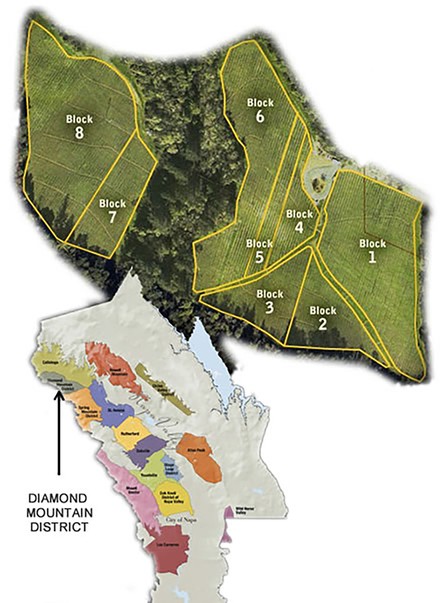Napa Valley’s
Diamond Mountain District Appellation
The Diamond Mountain District is an appellation is in the Northwest corner of the Napa Valley, California. The 5,000 acre appellation has just over 500 acres under vine due to the sloped terrain of the Mayacamas Mountain range. It sits at a higher elevation of 400-2200 feet which reduces the fog impact compared to the Napa Valley floor. The appellation has moderately warm temperatures with lower maximum temperatures and higher minimum temperatures than the valley floor, due to topography and altitude. The soil is reddish in color, fine grained, gritty in nature, and has volcanic origin. Cabernet Sauvignon from the appellation is known to have chewy tannins and higher acidity, which produces a wine that can age well in the cellar. Cabernet Sauvignon is the diamond grown on the mountain, but Cabernet Franc is also making a name for itself. The Diamond Mountain District AVA was declared a sub appellation of the Napa Valley in 2001 with Schramsberg Vineyards being the oldest winery in the appellation, which started in 1863.

For more information on the different appellations of the Napa Valley, visit the Napa Valley Vintners webpage.
In 1997 Marilyn and Edward planted the vineyard on a 10 acre parcel in the heart of the Diamond Mountain District at an elevation between 600-800 feet. The vineyard is planted in eight distinct blocks on a spacing of 4 X 7. There are 6 blocks of Cabernet Sauvignon, 1 block Petit Verdot, and 1 block Cabernet Franc. It is comprised of three main soil types: Aiken Loam, Boomer-Forward-Felta complex and the Forward-Kidd complex. These soils are classic well drained soils which make the vines work hard for moisture and nutrients. A mix of rootstocks and clones were chosen to give the wine great complexity and structure and to express the uniqueness of this site. These soils coupled with an excellent vineyard orientation and design lend themselves to exceptionally long hang time and really leave the wine making team many options during harvest.
The vineyard is immaculately farmed, and the fruit quality, and finished wine, is superior because of this attention to detail.
